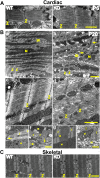Knockout of Lmod2 results in shorter thin filaments followed by dilated cardiomyopathy and juvenile lethality
- PMID: 26487682
- PMCID: PMC4640780
- DOI: 10.1073/pnas.1508273112
Knockout of Lmod2 results in shorter thin filaments followed by dilated cardiomyopathy and juvenile lethality
Abstract
Leiomodin 2 (Lmod2) is an actin-binding protein that has been implicated in the regulation of striated muscle thin filament assembly; its physiological function has yet to be studied. We found that knockout of Lmod2 in mice results in abnormally short thin filaments in the heart. We also discovered that Lmod2 functions to elongate thin filaments by promoting actin assembly and dynamics at thin filament pointed ends. Lmod2-KO mice die as juveniles with hearts displaying contractile dysfunction and ventricular chamber enlargement consistent with dilated cardiomyopathy. Lmod2-null cardiomyocytes produce less contractile force than wild type when plated on micropillar arrays. Introduction of GFP-Lmod2 via adeno-associated viral transduction elongates thin filaments and rescues structural and functional defects observed in Lmod2-KO mice, extending their lifespan to adulthood. Thus, to our knowledge, Lmod2 is the first identified mammalian protein that functions to elongate actin filaments in the heart; it is essential for cardiac thin filaments to reach a mature length and is required for efficient contractile force and proper heart function during development.
Keywords: actin-thin filaments; cardiomyopathy; cytoskeletal dynamics.
Conflict of interest statement
The authors declare no conflict of interest.
Figures













Similar articles
-
Disruption of cardiac thin filament assembly arising from a mutation in LMOD2: A novel mechanism of neonatal dilated cardiomyopathy.Sci Adv. 2019 Sep 4;5(9):eaax2066. doi: 10.1126/sciadv.aax2066. eCollection 2019 Sep. Sci Adv. 2019. PMID: 31517052 Free PMC article.
-
Cardiac-specific knockout of Lmod2 results in a severe reduction in myofilament force production and rapid cardiac failure.J Mol Cell Cardiol. 2018 Sep;122:88-97. doi: 10.1016/j.yjmcc.2018.08.009. Epub 2018 Aug 11. J Mol Cell Cardiol. 2018. PMID: 30102883 Free PMC article.
-
LMOD2-related dilated cardiomyopathy presenting in late infancy.Am J Med Genet A. 2022 Jun;188(6):1858-1862. doi: 10.1002/ajmg.a.62699. Epub 2022 Feb 21. Am J Med Genet A. 2022. PMID: 35188328 Free PMC article.
-
Assembly and Maintenance of Sarcomere Thin Filaments and Associated Diseases.Int J Mol Sci. 2020 Jan 15;21(2):542. doi: 10.3390/ijms21020542. Int J Mol Sci. 2020. PMID: 31952119 Free PMC article. Review.
-
Tropomodulin capping of actin filaments in striated muscle development and physiology.J Biomed Biotechnol. 2011;2011:103069. doi: 10.1155/2011/103069. Epub 2011 Oct 17. J Biomed Biotechnol. 2011. PMID: 22013379 Free PMC article. Review.
Cited by
-
Thin filament length in the cardiac sarcomere varies with sarcomere length but is independent of titin and nebulin.J Mol Cell Cardiol. 2016 Aug;97:286-94. doi: 10.1016/j.yjmcc.2016.04.013. Epub 2016 Apr 30. J Mol Cell Cardiol. 2016. PMID: 27139341 Free PMC article.
-
The N-terminal tropomyosin- and actin-binding sites are important for leiomodin 2's function.Mol Biol Cell. 2016 Aug 15;27(16):2565-75. doi: 10.1091/mbc.E16-03-0200. Epub 2016 Jun 15. Mol Biol Cell. 2016. PMID: 27307584 Free PMC article.
-
Increased Cardiac Arrhythmogenesis Associated With Gap Junction Remodeling With Upregulation of RNA-Binding Protein FXR1.Circulation. 2018 Feb 6;137(6):605-618. doi: 10.1161/CIRCULATIONAHA.117.028976. Epub 2017 Nov 3. Circulation. 2018. PMID: 29101288 Free PMC article.
-
Whole-Exome Sequencing Identifies Homozygote Nonsense Variants in LMOD2 Gene Causing Infantile Dilated Cardiomyopathy.Cells. 2023 May 23;12(11):1455. doi: 10.3390/cells12111455. Cells. 2023. PMID: 37296576 Free PMC article.
-
Titin-truncating mutations associated with dilated cardiomyopathy alter length-dependent activation and its modulation via phosphorylation.Cardiovasc Res. 2022 Jan 7;118(1):241-253. doi: 10.1093/cvr/cvaa316. Cardiovasc Res. 2022. PMID: 33135063 Free PMC article.
References
-
- Gregorio CC, Weber A, Bondad M, Pennise CR, Fowler VM. Requirement of pointed-end capping by tropomodulin to maintain actin filament length in embryonic chick cardiac myocytes. Nature. 1995;377(6544):83–86. - PubMed
Publication types
MeSH terms
Substances
Grants and funding
LinkOut - more resources
Full Text Sources
Other Literature Sources
Molecular Biology Databases
Research Materials

